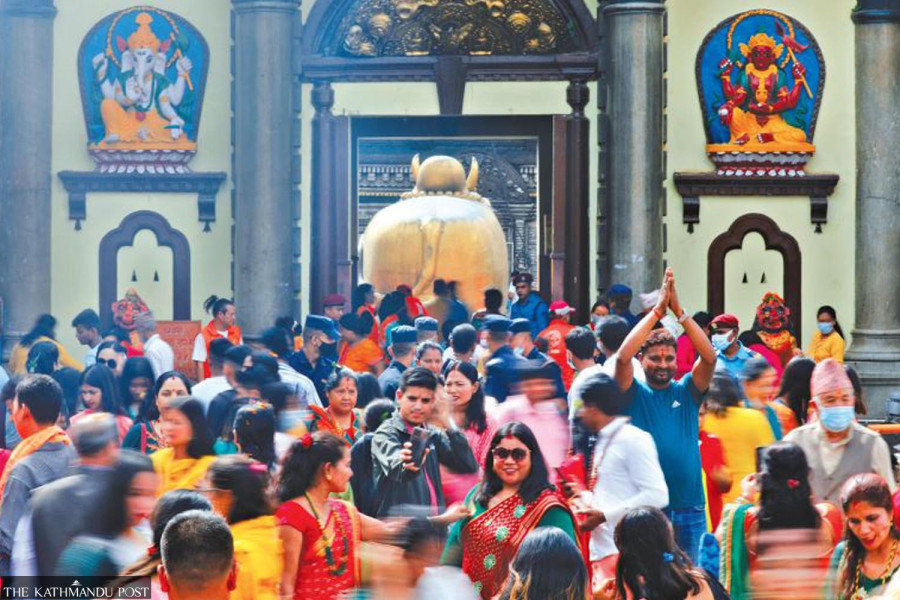Valley
Increase in footfall at Pashupatinath exposes temple Trust’s mismanagement
The Pashupati Area Development Trust has failed to run the day-to-day management and complete the restoration of the quake-damaged shrines, visitors and priests say.
Anup Ojha
When Bhagawati Sharma finally reached the southern door of the Pashupatinath temple with her son on Monday, they had already spent more than three hours standing in a queue.
“It was so crowded the queues snaked from outside the temple premises to the main temple,” said Sharma, 64, who lives at Ekantakuna in Lalitpur. “Everything was a mess.”
Sharma was among the crowds of people who visited the Pashupatinath temple for worship on the third Monday of the Nepali month of Shrawan. Mondays of Shrawan are considered especially auspicious for Shiva worship and devotees, especially women, observe a fast.
If it took Sharma and her son almost three hours to reach the south door, reaching there didn’t make it any easier for the duo to enter the main temple. It, in fact, added more chaos to her already stressful visit.
For one thing, the entrance was dirty and muddy after rainfall, Sharma said. Then the whole stretch was full of beggars and the toilets did not have running water. There weren’t enough volunteers to manage the crowd this year, according to Sharma. “The management on the temple premises was virtually non-existent,” she said.
The Pashupatinath temple, the richest shrine in the country, sees high footfall in the month of Shrawan every year which in turn exposes the limitations of the Pashupati Area Development Trust, the body responsible for the management of the temple premises.
According to the Trust, the temple receives around 100,000 visitors daily from across the country and neighbouring India during the month of Shrawan, which began on July 17. The number doubles to over 200,000 on Mondays and on Saturdays, the weekend holiday.
Not only the visitors, the temple’s priests too complain of the hassles caused by mismanagement and the Trust’s failure to manage the crowd.
“Everything is a mess here,” said Kedar Man Bhandari, chairperson of Pashupatinath Sewak Sangh and a priest at the temple. “Many Nepalis believe that Pashupatinath is the country’s patron god. But the way the temple is being treated does not suggest that the Trust officials hold the god in high regards.”
Bhandari added the Trust has failed to run the day-to-day management and complete the restoration of earthquake-damaged temples, pointing to the sorry state of the shrines around Ram Mandir, Rajarajeshwari ghat, Jaya Bageshwari temple, Vishwarup temple and a dozen other shrines in the Pashupati area.
“The Trust has enough money to complete the reconstruction work. They can also bring additional resources to manage the crowd when Pashupatinath sees high footfall,” said Bhandari. “But they haven’t done anything of the sort.”
In 2019, the Trust through a special committee released the details of its property acquired in the last 56 years—from 1962 to 2019. The temple had Rs1.2 billion cash in different banks, 9.276 kg gold, 316.58 kg silver and 3,667 ropani of land to its name.
“Every day hundreds of thousands of people are facing difficulties here, but the Trust does not seem to care,” said Bhandari. “If you walk around the temple premises, you’ll see how chaotic everything is.”
According to Narayan Subedi, treasurer of the Trust, it collected an estimated Rs734 million from cash offerings from devotees, rent from shops and land plots in the Pashupati area in the fiscal year 2021-2022.
In February 2021, the Trust had installed a 96 kg golden Jahalari in the sanctum sanctorum of the temple ignoring a stay order of the Supreme Court. Heritage activists called the installation unnecessary as it went against the Ancient Monument Preservation Act, 2013, which states that structures over 100-year-old must be preserved in their original design.
In 2018, the Trust announced the Pashupatinath area as a beggar-free zone and for a year tried to keep beggars out of the premises. Some beggars were moved to the Manab Sewa Ashram, a shelter, at Samakushi. However, the following year, the number of beggars inside the Pashupatinath area had doubled. Now, there are already over 400 beggars in the Pashupati area, according to Bhandari, the priest.
The Trust had planned to move the shops and stalls lining the pathway towards the temple into a 56-shutter complex in the Bankali area constructed in 2016. From flower sellers to those selling souvenirs to visitors were to be moved to the complex but the plan has yet to materialise.
Milan Kumar Thapa, member secretary of the Pashupati Area Development Trust, maintained that the Trust is constantly working to improve the experience for visitors.
Stating that the shortage of staff has affected the management of the Pashupatinath temple area, Thapa said that the Trust plans to hire 60 additional staff on a contract basis to lighten the load of the current 20 employees of the Trust.
“I haven’t been to the temple in the last two weeks,” Thapa said. “I’ll go there soon and try to solve the issues.”




 12.12°C Kathmandu
12.12°C Kathmandu.jpg)









%20(1).jpg&w=300&height=200)

